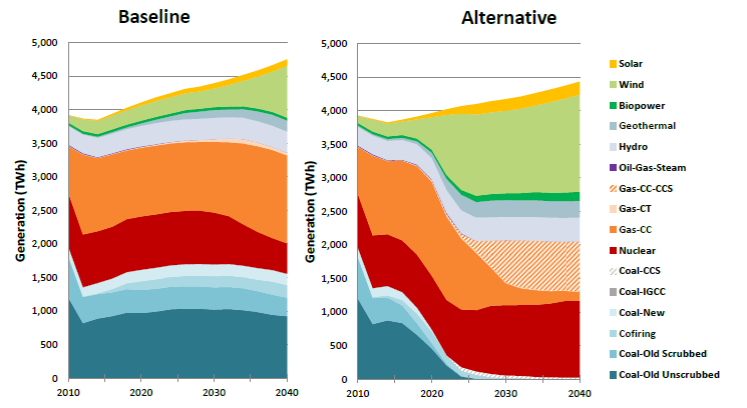Synapse and REMI Couple Electric-Sector Optimization Model with Macroeconomic Tool to Analyze Implications of National and State-Specific Carbon Taxes
In 2014, Synapse worked with Regional Economic Models, Inc. (REMI) on two projects to integrate Synapse’s in-house version of ReEDS, a detailed electricity sector optimization model developed by NREL, with REMI’s macroeconomic analysis tool, PI+. This integration gives a high-resolution view of the effect of changing energy prices and investment decisions on job creation, GDP, and income, as well as differential impacts by income group, industry, or region. Synapse and REMI analyzed both a nationwide and a Massachusetts-specific carbon tax.
Synapse and REMI initially explored this two-pronged approach with an analysis of a nationwide fee-and-dividend carbon policy with several stringency levels. Our analysis showed that such a policy would reduce carbon dioxide emissions 33 percent below the baseline in 2025, and 52 percent below in 2035. This significant shift in power production would result in a modest rise in electricity prices, but the dividend paid to consumers would more than make up for it, leading to a large net increase in GDP and employment.
Figure 1. Changes in generation as a result of nationwide fee-and-dividend carbon policy

Synapse and REMI used this same set of tools more recently to review the impacts of a similar revenue-neutral carbon fee that could be implemented in Massachusetts. Synapse advised the study team on how a state-specific policy could be implemented as part of a larger regional electricity system. Synapse modeled several different approaches in ReEDS, including taxing imported power based on an assumed level of carbon content, adjusting the stringency of the regional cap-and-trade system (RGGI), and simplifying the demand-side tax. Many of the scenarios created an incentive for Massachusetts to increase imports from out-of-state generators not facing the tax, while the demand-side tax put a small downward pressure on demand by increasing prices, but did not substantially alter electric-sector supply. The sub-state resolution of the ReEDS model was essential in considering these policies in detail.